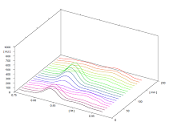Phytoconstituents of Nigella Sativa and Quantitative Densitometric Analysis of its Bioactive Compound Thymoquinone

Abstract:
Herbal plants are a reservoir of potential
phytochemical compounds and the richest bioresource of drugs for traditional systems
of medicine, nutraceuticals, food supplements, modern medicines, pharmaceutical
intermediates, folk medicines, and chemical entities for synthetic drugs. In the
present study we find out phytoconstituents of Nigella sativa and quantitative densitometric
analysis of its bioactive compound thymoquinone in the different solvent extracts.
It was found that Nigella sativa seeds were extracted with ethanol, methanol, and
benzene as solvents. Phytochemical analysis showed the presence of potent bioactive
constituents such as alkaloids, phenols, tannins, trepenoid, saponins, and steroids
in methanol extract. Benzene extracts have only alkaloids and steroids. While ethanol
extract showed the presence of alkaloids, phenols, tannins, proteins, amino acids,
flavonoids, terpenoids, saponins, and steroids. The
high-performance thin layer chromatographic method (HPTLC) was employed to quantify
and densitometrically analyze thymoquinone in methanol, ethanol, and benzene extract
of Nigella sativa. The analysis was performed on an aluminum plate with a mobile
phase of n-hexane: ethyl acetate: methanol (7:2:1 v/v/v) and a densitometric measurement
using a TLC scanner (CAMAG) at 254 nm. The ethanol extract of N. Sativa exhibited single sharp peak of thymoquinone with 0.85
Rf value,
the highest area of the band 8137.6, and
a total recovery of was 98.08% which is nearly equal to the standard thymoquinone
with Rf value (0.85), the highest area of the band 8789.4 and total recovery was obtained 100%. The present research indicated that
purified thymoquinone from N. sativa is a potential source for therapeutic application.
Keywords: Phytoconstituents, Herbal
extract, Essential oil, Quantification, Chromatography.
References:
[1] Chhetri, H. P., Yogol, N. S., Sherchan, J., Anupa, K. C.,
Mansoor, S., & Thapa, P. (2008). Phytochemical and anti-microbial
evaluations of some medicinal plants of Nepal. Kathmandu University Journal of
Science, Engineering, and technology, 4(1), 49-54.
[2] Ahmad, M., Khan,
M. A., Marwat, S. K., Zafar, M., Khan, M. A., Hassan, T. U., & Sultana, S.
(2009). Useful medicinal flora is enlisted in Holy Quran and Ahadith. Am
Eurasian J Agric Environ Sci, 5(1), 126-40.
[3] Ali, S. A., Parveen, N., & Ali, A. S. (2018). Links
between the Prophet Muhammad (PBUH) recommended foods and disease management: A
review in the light of modern superfoods. International Journal of Health
Sciences, 12(2), 61.
[4] Ncube, N. S.,
Afolayan, A. J., & Okoh, A. I. (2008). Assessment techniques of anti-microbial
properties of natural compounds of plant origin: current methods and future
trends. African Journal of Biotechnology, 7(12).
[5] Paarakh, P. M.
(2010). Nigella sativa Linn. –A comprehensive review, Indian Journal of Natural Products and
Resources. 1(4):
409 -429.
[6] Toncer, O., & Kizil, Süleyman. (2004). Effect of seed
rate on agronomic and technologic characters of Nigella sativa L. International
Journal of Agriculture and Biology, 6(3), 529-532.
[7] Ishtiaq, S., Ashraf, M., Hayat, M. Q., & Asrar, M.
(2013). Phytochemical analysis of Nigella sativa and its antibacterial activity
against clinical isolates identified by ribotyping. International Journal of
Agriculture and Biology, 15(6).
[8] Abu-Al-Basalc, M. A. (2009). In vitro and in vivo
anti-microbial effects of Nigella sativa Linn. seed extracts against clinical
isolates from skin wound infections. American Journal of Applied Sciences,
6(8), 1440.
[9] Salehi, B., Quispe, C., Imran, M., Ul-Haq, I., Živković, J.,
Abu-Reidah, I. M., ... & Sharifi-Rad, J. (2021). Nigella Plants–Traditional
Uses, Bioactive Phytoconstituents, Preclinical and Clinical Studies. Frontiers
in pharmacology, 12, 417.
[10] Khan, M. A. (1999). Chemical composition and medicinal
properties of Nigella sativa Linn. Inflammo pharmacology, 7(1),
15-35.
[11] Sayeed, M. S. B., Asaduzzaman, M., Morshed, H., Hossain, M.
M., Kadir, M. F., & Rahman, M. R. (2013). The effect of Nigella sativa
Linn. seed on memory, attention, and cognition in healthy human volunteers. Journal
of Ethnopharmacology, 148(3), 780-786.
[12] Bordoni, L., Fedeli, D., Nasuti, C., Maggi, F., Papa, F.,
Wabitsch, M., ... & Gabbianelli, R. (2019). Antioxidant and anti-inflammatory
properties of Nigella sativa oil in human pre-adipocytes. Antioxidants, 8(2),
51.
[13] Shah, F., Hasan, Z., & Zaidi, K. U. (2016). Evaluation
of Phyto constituent and synergistic antibacterial activity of Ocimum sanctum
extract against some gram-positive and gram-negative species. Bioscience
Biotechnology Research Communications, 9(4), 856-864.
[14] Zaidi, K. U., Shah, F., Parmar, R., & Thawani, V.
(2018). Anticandidal synergistic activity of Ocimum sanctum and fluconazole of
azole resistance strains of clinical isolates. Journal de Mycologie Médicale,
28(2), 289-293.
[15] Trease G, Evans W. Pharmacognocy. London: Bailliere
Tindall; 1989. p. 45–50.
[16] Sharma, V.,
Shukla, V. J., & Prajapati, P. K. (2012). Quantitative estimation of Aloin
from pharmaceutical dosage by HPTLC. Pharma Science Monitor, 3(1).
[17] Tiwari, P., Jena, S., Satpathy, S., & Sahu, P. K.
(2019). Nigella sativa: Phytochemistry, pharmacology and its therapeutic
potential. Research Journal of Pharmacy and Technology, 12(7),
3111-3116.
[18] Aftab, A., Yousaf, Z., Aftab, Z. E. H., Younas, A., Riaz,
N., Rashid, M., ... & Javaid, A. (2020). Pharmacological screening and
GC-MS analysis of vegetative/reproductive parts of Nigella sativa L. Pakistan Journal of Pharmaceutical Sciences,
33(5).
[19] Tayade, N. G., & Nagarsenker, M. S. (2007). Validated
HPTLC method of analysis for artemether and its formulations. Journal of
pharmaceutical and biomedical analysis, 43(3), 839-844.
[20] Kaur, A.D., Ravichandran, V., Jain, P.K., Agrawal, R.K.,
(2008). High-performance thin
layer chromatography method for estimation of conessine in herbal extract and
pharmaceutical dosage formulations. J Pharm Biomed Anal 46: 391–394.
[21] Taleuzzaman, M., Imam, S. S., & Gilani, S. J. (2017).
Quantitative Determination of thymoquinone in Nigella Sativa and its nano
formulation using validated stability indicating HPTLC densiometric method. International
Current Pharmaceutical Journal, 6(10), 53-60.
[22] Alam, P., Yusufoglu, H., & Alam, A. (2013). HPTLC
densitometric method for analysis of thymoquinone in Nigella sativa extracts
and marketed formulations. Asian Pacific Journal of Tropical Disease, 3(6),
467-471.
[23] Belete, Y., & Dagne, E. (2014). HPTLC assay of
thymoquinone in black seed and black seed oil (Nigella Sativa Linn) and
identification of thymoquinone conversion with Uv-Vis. Journal of Drug
Delivery and Therapeutics, 4(4), 5-9.

